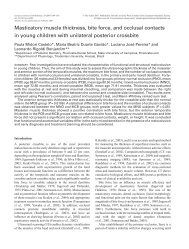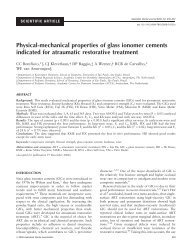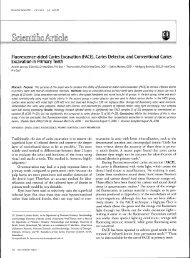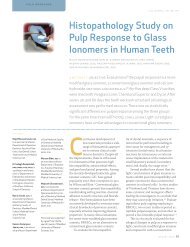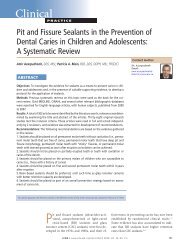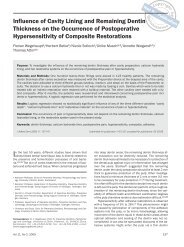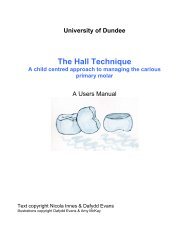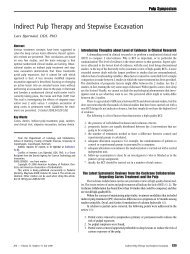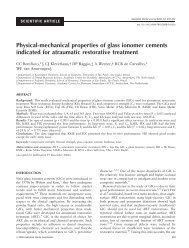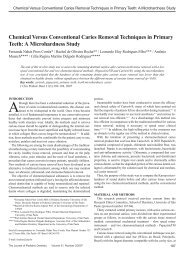View - Sandra Kalil Bussadori
View - Sandra Kalil Bussadori
View - Sandra Kalil Bussadori
You also want an ePaper? Increase the reach of your titles
YUMPU automatically turns print PDFs into web optimized ePapers that Google loves.
nostic threshold all histological scores 1–4 were classed as caries<br />
and each ICDAS-II cut-off was used to calculate sensitivity and<br />
specificity for each examiner. Similarly for the D3 diagnostic<br />
threshold histological scores 3 and 4 were classed as caries only<br />
and sensitivity and specificity calculated at each ICDAS-II cutoff.<br />
The ERK histology, using the classification 2–3 as a histological<br />
threshold, was also used to calculate sensitivity and specificity<br />
for each ICDAS-II cut-off. Using these sensitivity and specificity<br />
values ROC analyses were carried out at the D1, D3 and ERK<br />
2–3 thresholds for each examiner.<br />
Table 3. Inter- and intra-examiner reproducibilities for visual<br />
ICDAS-II examinations<br />
Weighted kappa<br />
examiner 1 examiner 2 examiner 3 examiner 4<br />
Examiner 1 0.82 0.74 0.77<br />
Examiner 2 0.78 a 0.70 0.74<br />
Examiner 3 0.74 a 0.62<br />
Examiner 4<br />
0.83 a<br />
a<br />
Intra-examiner data in italics.<br />
R e s u l t s<br />
Initially, 100 teeth and up to 4 sections per independent<br />
investigation site were planned for investigation,<br />
but, owing to section damage on some teeth and to some<br />
not being scored by all examiners, only 93 investigation<br />
sites and 201 corresponding sections were available for<br />
analysis (14 investigations sites had 1 section, 54 had 2<br />
sections, 21 had 3 sections and 4 had 4 sections). The<br />
number of sections per investigation site was dictated by<br />
the size and spread of the lesion.<br />
Three or more examiners agreed on the histological<br />
assessment in 89% of investigation sites when using the<br />
Downer classification and 84% of investigation sites when<br />
using the ERK classification. The interexaminer weighted<br />
kappa values were 0.66–0.75 for the Downer classification<br />
and 0.60–0.74 for the ERK classification. Where disagreement<br />
occurred, a consensus decision was made following<br />
discussion and this was used in subsequent<br />
analyses.<br />
Table 3 shows the intra- and interexaminer reproducibilities<br />
(kappa values) for the visual ICDAS-II examinations.<br />
Table 4 shows the distribution of ICDAS-II data crosstabulated<br />
with both the Downer and ERK histological<br />
scores (consensus) for the independent investigation sites<br />
included in this study for the reference examiner. Table 5<br />
Table 4. Cross tables showing the relationship between the<br />
ICDAS-II scores for examiner 1 and the consensus decision for<br />
Downer and ERK histological classification systems for the independent<br />
data<br />
ICDAS-II<br />
0 1 2 3 4 5 6<br />
Downer histological score<br />
0 15 7 0 0 0 0 0 22<br />
1 4 4 4 1 0 0 0 13<br />
2 2 4 6 1 0 1 1 15<br />
3 0 5 5 14 6 6 0 36<br />
4 0 0 0 0 2 4 1 7<br />
Total 21 20 15 16 8 11 2 93<br />
ERK histological score<br />
0 15 7 0 0 0 0 0 22<br />
1 4 4 4 1 0 0 0 13<br />
2 2 5 10 9 2 2 1 31<br />
3 0 4 1 6 4 6 0 21<br />
4 0 0 0 0 2 3 1 6<br />
Total 21 20 15 16 8 11 2 93<br />
Table 5. Spearman’s correlation coefficients: visual versus histological scores<br />
Spearman’s correlation coefficient<br />
examiner 1 examiner 2 examiner 3 examiner 4 all examiners<br />
Visual versus Downer histological scores 0.60 0.72 0.59 0.48 0.58<br />
Visual versus ERK histological scores 0.58 0.68 0.54 0.43 0.54<br />
Reproducibility/Accuracy of a Method for<br />
Caries Detection<br />
Caries Res 2008;42:79–87 83





